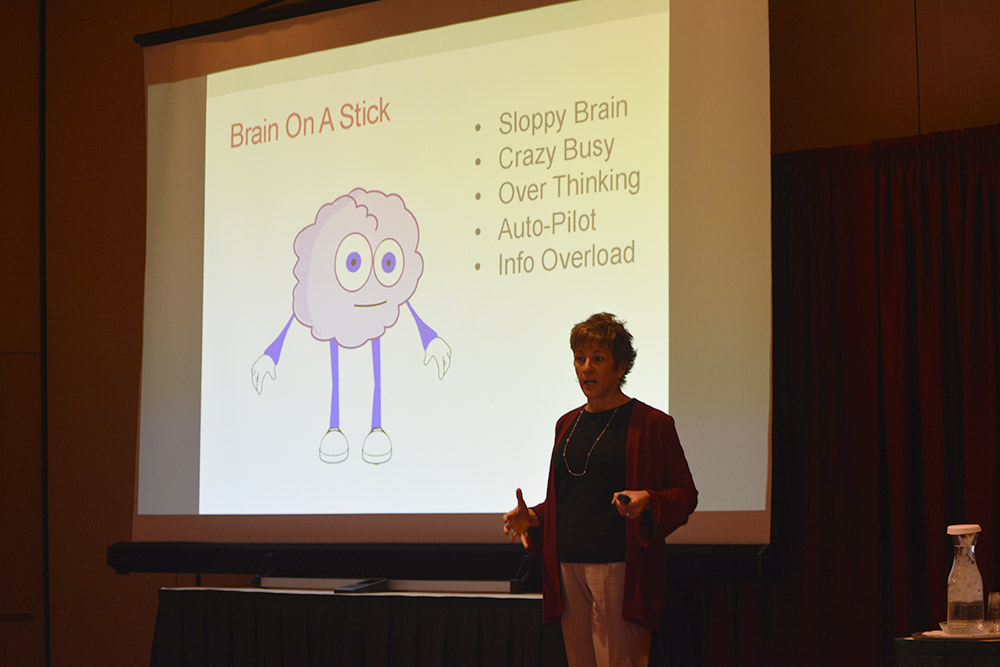
Self-Care Mini Wins Help Employees Embrace Well-Being
Simple, easy-to-do strategies can help you get out of your own head and in touch with your body so you can quickly regain a sense of well-being.
Cara Bradley. External Link. Opens in new window. demonstrated these “self-care mini wins” with the audience at The Monona Terrace on Jan. 15 during The Alliance Learning Circle on Wellness & Caregiving Benefits: Healthy Minds, Healthy Employees, Healthy Company.
Taking time to learn self-care techniques – and practice them regularly –will improve your well-being in ways that benefit you in your personal life, as an employee and as a caregiver for others, Bradley said.
‘Brain on a Stick’
Bradley. External Link. Opens in new window. is an innovative body-mind teacher who is committed to helping people shift from “frazzled” to “flow,” defined as the “optimal state where we live our best and do our best.” She is the founder of the Verge Body Mind Center. External Link. Opens in new window. in Philadelphia; a mindfulness and yoga teacher; and a mental strength coach for CEOs, corporations and sports teams.
“The greatest gift you can give the world is a fully healthy you,” Bradley said.
The biggest barrier to being fully healthy is our tendency to live in our heads, which is reinforced by our always-on culture. Bradley described this as feeling like a “brain on a stick,” where a constant stream of thoughts cuts us off at our neck. That means we are unable to benefit from our body’s built-in mechanisms for restoring balance.
“We cannot stop thinking and we don’t know what to do about it,” Bradley said. She outlines the following traits of busy mind in her book On The Verge. You many recognize a few in your behavior:
- Sloppy brain “where you do and say stupid stuff.”
- Crazy busy, using that term to describe your life as if it were a badge of honor instead of a barrier to meaningful connection.
- Overthinking by mentally spinning the same issues over and over again in your head.
- Auto-pilot behavior such as leaving work and then arriving home without a memory of your drive, or eating half your lunch before you realize you can’t recall what you ordered.
- Information overload from constant exposure to screens on smartphones, computers and even televisions embedded in gas station pumps.
Getting Back in Flow of Well-Being
People naturally prefer to live in “flow,” where they feel empowered, their senses are heightened and their inner critic quiets down. You can start to seek flow by practicing these three self-care tactics, or “mini wins.” Bradley said these tactics can help “reset” your nervous system.
- Sit upright in a chair with your feet on the floor and your hands resting lightly on your legs. Inhale deeply and then exhale deeply. Now breathe in and out five more times, slightly smaller than your initial breath, but still deeply. Try to still your thoughts. Bradley said this tactic will take you out of the slightly agitated state that typically occurs as we wait for the next email or the next news cycle that delivers bad news.
- Be Silent. Sit in a comfortable position. Now listen to what is happening, first in your own head and then in the world around you. Bradley said sitting in quiet has been proven to be more relaxing than listening to calming music. You can use this tactic before entering your office or home, providing caregiving for others or dealing with a messy problem.
- Bradley promotes using the Pomodoro Technique, which states that humans work best in 25-minute periods that consist of 20 minutes of work with a five-minute break. She led the audience through simple stretches that moved the spine forward, back, side to side and in a twisting motion. Other forms of movement can also be used to provide a movement break.
Embrace Four Practices
People can use ongoing habits to “tone and tune” the nervous system to move from continual agitation to consistently moving through the world in a calm, clear and strong manner. Bradley recommends four practices for well-being:
- Exercise. Bradley recommends exercises like yoga and tai chi that help get mind and body in tune.
- People too often breathe shallowly, which allows the diaphragm to atrophy. To get your breathing back in shape, practice coherent or qigong breathing.. External Link. Opens in new window.
- Train yourself to notice your breath and notice your thoughts with practices such as mindfulness meditation.. External Link. Opens in new window.
- Experience Nature. “Being in nature, just by being there, helps us to become clearer, calmer and stronger,” Bradley said. Look for regular opportunities to experience nature as “the best medicine.”
Aim to Stay in Flow
Being in flow will make a difference not only in your life, but the lives of all those who interact with you.
“By being in our body, by noticing and prioritizing our state of being, we can then support others in another way,” Bradley said.
What Employers Can Do
Bradley said each individual and each organization is different, which means they will help employees find “flow” differently. The key is to find approaches that help your employees move at regular intervals, take a break to breathe and find quiet time to refresh. Options might include:
- Creating an environment that mimics natural lighting.
- Starting a meeting with a moment of quiet reflection.
- Offering support for employees who want to take a walk during work hours.
- Encouraging employees to take regular breaks.







